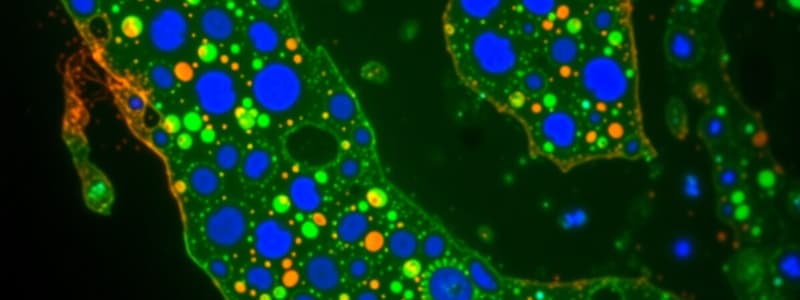Podcast
Questions and Answers
Direct Immunofluorescence (DIF) detects ______ in a sample using a primary antibody directly conjugated to a fluorescent dye.
Direct Immunofluorescence (DIF) detects ______ in a sample using a primary antibody directly conjugated to a fluorescent dye.
antigens
Indirect Immunofluorescence Assay (IDIFA) detects ______ in a patient’s serum by binding them to antigens and using a secondary fluorescent antibody.
Indirect Immunofluorescence Assay (IDIFA) detects ______ in a patient’s serum by binding them to antigens and using a secondary fluorescent antibody.
antibodies
In DIF, the ______ antibody is fluorescently labeled.
In DIF, the ______ antibody is fluorescently labeled.
primary
In IDIFA, both the ______ and secondary antibody are fluorescently labeled.
In IDIFA, both the ______ and secondary antibody are fluorescently labeled.
DIF involves a single step: antigen + ______ antibody.
DIF involves a single step: antigen + ______ antibody.
IDIFA involves two steps: antigen + primary antibody, then ______ antibody.
IDIFA involves two steps: antigen + primary antibody, then ______ antibody.
DIF identifies ______ directly in tissue or cells.
DIF identifies ______ directly in tissue or cells.
IDIFA detects ______ present in a serum sample.
IDIFA detects ______ present in a serum sample.
DIF is highly specific but limited to the ______ antibody.
DIF is highly specific but limited to the ______ antibody.
IDIFA is more versatile, as different primary antibodies can use the same ______ antibody.
IDIFA is more versatile, as different primary antibodies can use the same ______ antibody.
Immunofluorescence (IF) is a technique that visualizes a specific ______ by binding a specific antibody conjugated with a fluorescence dye.
Immunofluorescence (IF) is a technique that visualizes a specific ______ by binding a specific antibody conjugated with a fluorescence dye.
Fluorescent dyes absorb ______ wavelength UV radiation and emit light of a longer wavelength, often in the visible spectrum.
Fluorescent dyes absorb ______ wavelength UV radiation and emit light of a longer wavelength, often in the visible spectrum.
Fluorescein isothiocyanate (FITC) is a common fluorescent dye that emits ______ light.
Fluorescein isothiocyanate (FITC) is a common fluorescent dye that emits ______ light.
Tetramethylrhodamine, another fluorescent dye, emits ______ light.
Tetramethylrhodamine, another fluorescent dye, emits ______ light.
Immunofluorescence can be used to make ______ more readily visible to the naked eye.
Immunofluorescence can be used to make ______ more readily visible to the naked eye.
Direct Immunofluorescence (DIF) detects specific ______ in tissue sections or cells using a single, fluorescently labeled primary antibody.
Direct Immunofluorescence (DIF) detects specific ______ in tissue sections or cells using a single, fluorescently labeled primary antibody.
In DIF, a fluorescently labeled antibody is applied to the sample and allowed to ______ to the antigen if present.
In DIF, a fluorescently labeled antibody is applied to the sample and allowed to ______ to the antigen if present.
Indirect Immunofluorescence Assay (IDIFA) detects the presence of specific ______ in a biological sample, typically serum.
Indirect Immunofluorescence Assay (IDIFA) detects the presence of specific ______ in a biological sample, typically serum.
A slide is coated with a specific ______ in IDIFA, and the sample containing antibodies is applied to the slide.
A slide is coated with a specific ______ in IDIFA, and the sample containing antibodies is applied to the slide.
In IDIFA, a fluorescently labeled ______ antibody binds to the patient's antibodies, leading to fluorescence.
In IDIFA, a fluorescently labeled ______ antibody binds to the patient's antibodies, leading to fluorescence.
Flashcards
Direct Immunofluorescence (DIF)
Direct Immunofluorescence (DIF)
Assay that detects antigens using a directly conjugated fluorescent primary antibody.
Indirect Immunofluorescence Assay (IDIFA)
Indirect Immunofluorescence Assay (IDIFA)
Assay that detects antibodies in serum by binding to antigens and using a secondary fluorescent antibody.
Fluorescence Label
Fluorescence Label
A fluorescent dye attached to antibodies for visualization under a microscope.
Specificity
Specificity
Signup and view all the flashcards
Sensitivity
Sensitivity
Signup and view all the flashcards
Applications of DIF
Applications of DIF
Signup and view all the flashcards
Applications of IDIFA
Applications of IDIFA
Signup and view all the flashcards
Time and Cost of DIF
Time and Cost of DIF
Signup and view all the flashcards
Time and Cost of IDIFA
Time and Cost of IDIFA
Signup and view all the flashcards
Steps in DIF
Steps in DIF
Signup and view all the flashcards
Immunofluorescence (IF)
Immunofluorescence (IF)
Signup and view all the flashcards
Fluorescence Dye
Fluorescence Dye
Signup and view all the flashcards
Fluorescein Isothiocyanate (FITC)
Fluorescein Isothiocyanate (FITC)
Signup and view all the flashcards
Tetramethylrhodamine
Tetramethylrhodamine
Signup and view all the flashcards
Sample Preparation in DIF
Sample Preparation in DIF
Signup and view all the flashcards
Patient Serum Incubation in IDIFA
Patient Serum Incubation in IDIFA
Signup and view all the flashcards
Fluorescence Detection
Fluorescence Detection
Signup and view all the flashcards
Antigen Coating
Antigen Coating
Signup and view all the flashcards
Study Notes
Immunofluorescence
- Immunofluorescence is a technique used to visualize specific antigens.
- It involves binding a specific antibody chemically conjugated with a fluorescent dye to the antigen.
- Fluorochromes are dyes that absorb short wavelength UV radiation and emit longer wavelength fluorescence (visible light).
- Fluorescein isothiocyanate (FITC) emits green light. Tetramethylrhodamine emits red light.
- This technique can make viral plaques more visible to the human eye.
Principle of Immunofluorescence (IF)
- IF is based on the specific antigen-antibody interaction.
- A labeled antibody binds to its corresponding antigen.
- Exposure to ultraviolet (UV) or specific wavelengths of light causes the fluorescent dye to emit visible light.
- This visualization allows observation of the antigen-antibody complexes.
Requirements of Immunofluorescence
- A slide
- A tagged antibody
- A fluorescent microscope
- Specimens
Methods of Immunofluorescence Assay
- There are two types: direct and indirect.
Direct Immunofluorescence Assay (DIFA)
- A single fluorescently labeled primary antibody directly binds to the target antigen.
- The sample preparation includes fixing tissue sections or cells on a slide.
- The fluorescently labeled antibody is applied to the sample.
- Incubation allows the antibody to bind to the antigen if it is present.
- Using a fluorescence microscope, the presence of fluorescence confirms the target antigen.
Indirect Immunofluorescence Assay (IDIFA)
- Detects antibodies in serum.
- A slide or substrate is coated with a specific antigen.
- The patient's serum sample (containing antibodies) is applied to the slide.
- If target antibodies are present, they bind to the antigen.
- A fluorescently labeled secondary antibody that binds to the patient's antibodies is added.
- Using a fluorescence microscope, the presence of fluorescence confirms the specific antibodies.
Result
- Confocal images can detect phosphorylated AKT (green) in cardiomyocytes infected with adenovirus.
Comparison of Direct and Indirect IF
| Aspect | Direct IF | Indirect IF |
|---|---|---|
| Definition | Detects antigens using a primary antibody directly conjugated to a fluorescent dye. | Detects antibodies using a secondary antibody binding to primary antibodies labeled with target antigen. |
| Fluorescence Label | Primary antibody is labeled. | Secondary antibody is labeled. |
| Steps | Single step: Antigen + labeled antibody. | Two steps: Antigen + primary antibody + secondary antibody. |
| Purpose | Identifies antigens directly. | Detects antibodies in a sample. |
| Specificity | Highly specific to the labeled antibody. | More versatile, as different primary antibodies can use the same labeled secondary antibody. |
| Sensitivity | Lower sensitivity due to lack of signal amplification. | Higher sensitivity due to amplification from secondary antibody binding. |
| Applications | Pathology, detecting tissue-bound antigens | Serological tests, autoimmune, infectious disease studies |
| Time and Cost | Faster and generally cheaper | More time-consuming and potentially more expensive |
Studying That Suits You
Use AI to generate personalized quizzes and flashcards to suit your learning preferences.




